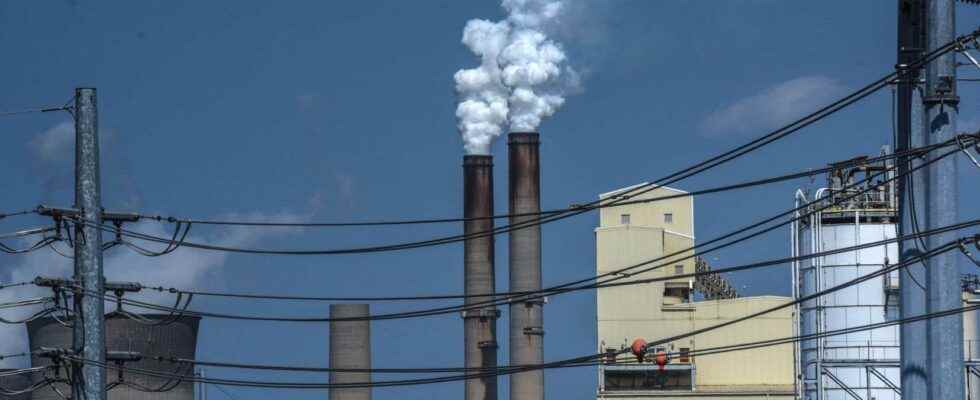In a decision handed down on Thursday, the United States Supreme Court limited the powers of the Environmental Protection Agency (EPA) to reduce greenhouse gas emissions. According to the highest US court, the federal agency would exceed its mandate if it orchestrated a national transition to renewable electricity. Decryption in four questions by our journalist from the Environment Pole Alexis Riopel.
What does the decision prevent?
The judgment signed by six of the nine magistrates of the American high court affirms that the EPA must content itself with regulating the polluting emissions spit by the chimneys of power plants. Restructuring the “nation’s energy cocktail” — a systemic action with major economic consequences — requires explicit direction from the United States Congress, according to the document.
The decision prevents the EPA from promoting a “generational transition” of the American electricity production fleet to gradually get it out of coal. In practice, therefore, the Agency cannot use emission capping systems. Its action must rather concern rules with which each coal-fired power plant can hope to comply.
“What would be the best system to reduce carbon emissions from coal-fired power plants? The answer is obvious: stop using them. It’s the best system! In my opinion, it is obvious, but this is not how the Court saw things,” explains Patrick Parenteau, professor of environmental law at the University of Vermont.
Emissions from electricity generation in the United States amount to 1,500 million tons of CO equivalent2 per year, i.e. 25% of the country’s GHGs.
What is the cause leading to this decision?
This judgment, named West Virginia v. Environmental Protection Agencystems from the legal challenge led by some states (and by the coal industry) of an Obama-era project: the Clean Power Plan.
In accordance with this plan, the States should have gradually reduced the GHG emissions attributable to their electricity production. A reduction of 32% compared to 2005 values was targeted for 2030. To achieve this, States could add wind or solar installations to their electricity fleet, or submit energy companies to instruments such as carbon exchanges.
This initiative ultimately never saw the light of day. The Supreme Court had first temporarily blocked it in 2016 by simple decree, then the coming to power of President Donald Trump relegated it to oblivion. The US High Court has chosen to rule this week on the Clean Power Plan even though the EPA is currently working on a different plan, which is due to come into effect in 2024.
What does the decision not prevent?
Contrary to what some observers feared, the U.S. Supreme Court did not strip the EPA of its power to apply the Clean Air Act to CO2 emissions.2. However, in the electricity generation sector, its options are now seriously limited.
The agency could require existing power plants to improve their energy performance and therefore emit slightly less CO2 per unit of energy. However, this option would tend to delay the end of the era of fossil fuels.
The EPA could also, without contravening the new decision of the Supreme Court, require existing power plants to trap and sequester carbon at the outlet of their chimneys. It already requires partial trapping for new coal-fired power plants.
“However, I am certain that this option would be challenged in court,” says Deborah Sivas, professor of environmental law at Stanford University. Coal plant owners do not want these very expensive systems. They could argue that it’s not a technology that has been adequately demonstrated to be effective,” and therefore the EPA can’t force it on them.
Finally, the EPA could also require coal-fired power plants to adapt their facilities to burn a mixture of natural gas (methane) and coal, as some already do. However, taking into account leaks of methane — a more potent GHG than CO2 when it is not burnt — it is not certain that the climate will benefit from it. And in the best of cases, the gains would only be marginal.
The good news is that, even without regulation, market forces have taken a lot of feathers out of coal-fired power plants in recent years. “I don’t expect the new ruling to change the trajectory of coal in the United States, which is on a downward slope anyway,” says Professor Sivas. However, natural gas power plants have the wind in their sails.
What does this decision open the door to?
The recent decision undermines the power of US government agencies like the EPA. According to the doctrine of “major questions” deployed in the judgment, these administrative entities cannot henceforth make decisions with major economic consequences without an explicit mandate from the American Congress, since it is the latter who answers directly to the voters.
Of course, the US legislative branch could orchestrate a coal exit itself. However, a congressional deadlock makes that option highly unlikely in the near future, according to Ms.me Sivas. “And we are racing against the clock” in the climate file, she notes.
And if some analysts fear that West Virginia v. EPA could prevent the Agency from taking action to reduce emissions associated with the transportation sector, Patrick Parenteau doubts. In his opinion, since the latter has been steadily tightening its standards for polluting vehicle emissions for decades, it would be difficult for anyone to argue that a new turn of the screw would need the approval of elected officials.
However, it may be more difficult in the future for the EPA to regulate certain polluting industries similar in the form of their facilities to power plants — cement plants, for example. “I believe that these types of rules would be vulnerable to the same kind of argument based on the major issues doctrine,” concludes Professor Sivas.
